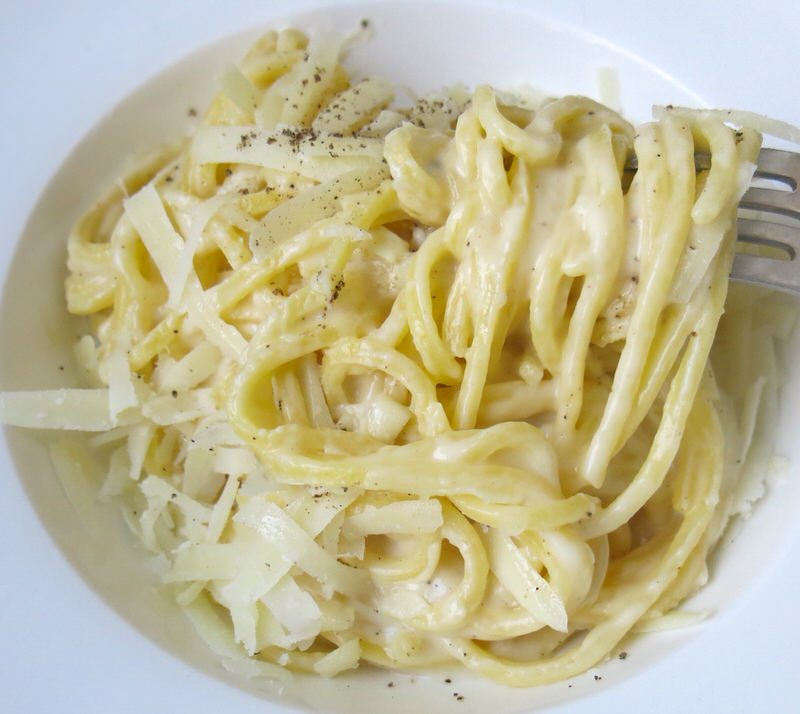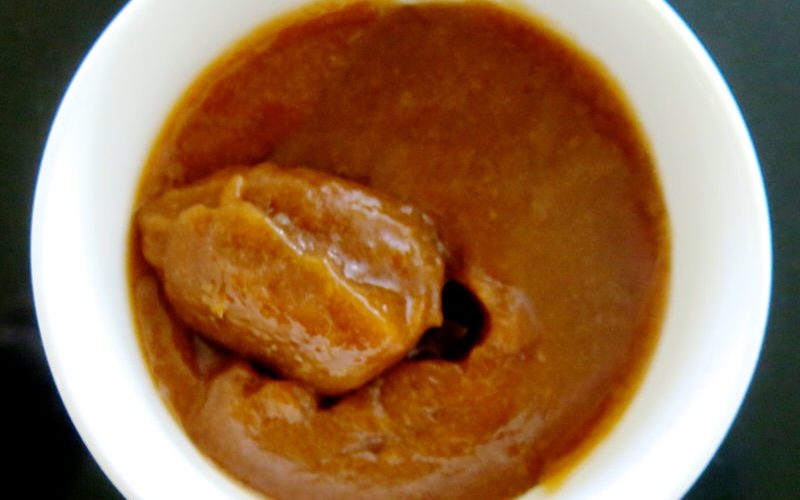Spaghetti Cacio e Pepe: Inspired by our friend, Laine
Cacio e Pepe Spaghetti? What are you raving about, Laine? Oh, my. He and wife, Nicole, travelled to New York and discovered Eataly while there. “I had the best pasta I have eaten in my life there.” It looks just like plain pasta with nothing on it at all, he explained. He was so surprised to see a plate of seemingly plain pasta set in front of Nicole and wondered why she ordered it. “She took one bite and her eyes completely lit up as she looked at me when tasting it.” He knew it was special. Tasted it and was hooked.
He described it with such passion and fervour that I was salivating at the dinner table Saturday night as we were all dining with friends. He said when they returned home, they looked it up and sure enough, the recipe was on the Eataly site. They picked up the ingredients at the Italian Center Shops (Edmonton and Calgary) and went home and made it. Was it good? “Absolutely! As good as it was there!”
I was so in after that commendation that I could hardly get over there fast enough Sunday morning to purchase the ingredients. And, was he right?
This is the most special pasta dish I have eaten. In my life. There are a few equal to it, very few and none better. The Pecorino Romano grated into the Caciocavallo Sauce to finish the Cacio e Pepe Spaghetti elevates the flavour profile and taste experience to a completely foreign place in time and space. Yet, this is not the traditional Cacio e Pepe recipe. Read on to learn of it.
Cacio e Pepe Spaghetti: A Little History of Caciocavallo cheese
The Italian Caciocavallo cheese itself hails from Southern Italy and the Balkans and if you are there, be sure to get the certified PDO Caciocavallo Silano which indicates that the product”… is produced, processed and prepared in a given geographical area using recognized know-how”. The Italian name of the cheese is literally translated to “horse cheese” as, due to the pear-like shape with the knob on the top, it is thought that two cheese forms were bound together with rope and then left to mature by placing straddling them on a branch. However, the Latin word cascabellus, meaning sleigh bell could also be where the name was derived as the shape of a hanging ball. The funk of the cheese varies from region to region, as one can imagine, due to the local terroir. A Caciocavallo from Puglia would be considerably different than one from Calabria. Certainly different than one from Canada. It is possible, however, that the cheese served in New York City at Eataly was Italian, as US cheese laws and accessibility are different than Canadian cheese laws.
Caciocavallo is a drawn or stretched curd cheese, ripened for a minimum of 15 days to two years and even longer, depending upon the region. The ripening process generates a mould and, when washed, the rind is hard and shiny. The texture may vary from semi-soft to semi-hard and it usually has an intense golden yellow colour and, if aged, with tiny, greasy cracks.
I recall it being sold everywhere when in Capril and Sorrento when I travelled there. I bought one (of course, I had to) and found it very unusual and addictive. The texture is softer and spongy: somewhat mozzarella-like which is not surprising as it is a stretched curd cheese like a mozzarella traditionally made with cow or sheep milk. My purchase was a younger “knobbed-boule”, so it was a little funky and I like funk in my cheese. The aged ones can get a strong barnyard funk going that some love and some find off-putting. The only one sold at the Italian Center (sadly) is the Made in Canada Saputo Caciocavallo: a mild, buttery cheese with little funk. It has a distinctively milder and more buttery flavour than even the young Caciocavallo I bought. Yet, the pasta was still worth the time and effort and now I have another experience to look forward to: Cacio e Pepe Spaghetti made with an Italian PDO certified Caciocavallo Silano.

Any Italians in Southern Italy interested in a postal transaction? Make sure you get two of the Saputo ones. Sadly, Saputo has 375 grams on the package and both of mine were exactly 235 grams. That is a significant difference! The recipe calls for 300 grams and one “should have” been enough for one batch. Fortunately, I wanted to make it twice, once with my Thermomix and once without, so I had purchased two.
Cacio e Pepe Spaghetti: A Little History of the Recipe
Cacio e Pepe is literally translated to “cheese and pepper” in the Roman dialect (Pecorino is also cacio in Roman dialect). The ingredients are that simple: freshly grated black pepper, Pecorino Romana and dried pasta. When preparing the dish, the cheese is grated and mixed into the strained pasta with some of the hot cooking water. The heat melts the cheese as the pasta is tossed in the water-cheese bath. The starch from the pasta thickens the sauce and enables it to adhere to the pasta with the pepper. Cacio e Pepe is typically made with long, thin spaghetti, such as tonnarelli or vermicelli.
The secret of a traditional Cacio e Pepe is the creamy sauce obtained by combining best quality Pecorino Romano with a little of the water used to cook the spaghetti. As the cheese and the starch from the pasta with a bit of the cooking water are the only ingredients necessary to make the traditional sauce. this Cacio e Pepe is different as the traditional recipe does not include Caciocavallo.
For centuries, Cacio e Pepe has been known as the meal of Roman shepherds. Dried pasta, aged pecorino and black pepper were easy-to-carry ingredients and hard to spoil during the months spent outside herding. The traditional recipe does not use oil, cream or butter. The starch inside the spaghetti coupled with the grated pecorino combine to create the sauce. Lots of freshly grated black pepper is key to this recipe, as it is in many Roman recipes.
Now that I have done my research and found the original traditional “recipe” here, I have yet another great cooking and eating experience to look forward to.
Cacio e Pepe Spaghetti: Mis en Place
Milk, Caciocavallo and Pecorino are all that is used in the sauce. Of course, three other major ingredients are missing from the above mis en place: the pasta, the water and the freshly grated black pepper. The Pecorino should be grated while the sauce is cooking and mixed in and melted with the pasta and cheese-milk “to taste”.
Cacio e Pepe Spaghetti: Separating the Curds from the Whey
The advantage of owning a Thermomix is using it for recipes like this. The cheese and milk needed to boil, then simmer for 40 minutes. The Thermomix brought it to a boil, then I turned it to simmer for 40 minutes with a soft stir.
The curds were minuscule. As I have made many kinds of homemade cheeses, I do know what a curd looks like, yet most definitely expected a larger curd. As the milk was ever so lightly agitated through the entire 40 minutes, larger curds were unable to form. No matter. I have a tamis that would capture minuscule curd, and that it did. The larger curds, if done on the stovetop, would be simply gathered with a spider and set aside. The Cacio e Pepe Spaghetti recipe says to toss them, but they are delicious. I send mine home with my mom to add some herbs to and spread on crackers. We do not waste in my kitchen.
Cacio e Pepe Spaghetti: Preparing the Pasta
Cheese-milk, top left, in all its flavourful glory took a good 40 minutes to heat and then a good 5 to 10 to remove the curds. Anticipation rising. I had purchased fresh pasta. An extravagance, yes. But, it was there and I was making a very simple recipe. We all know simple means the best of each ingredient. I do like making homemade pasta, but have never made spaghetti and really have no desire to. The fresh pasta from the Italian Center Shop was sublime.
Into the sauce it went with a whole lot of freshly ground black pepper. Then all was tossed and tossed and tossed and tossed, gently, thoroughly and steadily until the starch in the pasta gathered the sauce to adhere to it.
You will know when “it is done” as there is no more liquid in the pan. The sauce has thickened and adheres to the pasta so completely that there is really no sauce left in the pan at all. Add more pepper. This is also the time to start tossing in the Pecorino cheese. Toss and taste and add more and toss and taste. It will melt into the sauce and add the funk necessary to brighten the flavour and get those umami taste buds rocking and you will be salivating in the back of your mouth. (Too much information?)
Cacio e Pepe Spaghetti: Serving the Pasta
Serve the Cacio e Pepe Spaghetti in a bowl with more freshly grated black pepper. This dish awaits the pepper.
Gorgeous.
I added the grated cheese to the bowl of Cacio e Pepe Spaghetti and tossed it individually as I ate. That’s when I realized it was to be done in advance. And so gorgeous is this flavour.
I have developed an entirely new respect for pepper after tasting Cacio e Pepe Spaghetti.
Cacio e Pepe Spaghetti: Eating the Pasta

It is often difficult to describe tastes and flavours that are rare and unexpected. There is a buttery, salty, barnyard funk in a good way all dressed up in velvet sublimation. The picante nip of pepper adds a little perk to the party, yet aligns with the deep umami rhythm of each long succulent slurp.
Cacio e Pepe Spaghetti with Caciocavallo. Now that’s something. Thank you, Laine!
Spaghetti Cacio e Pepe
Ingredients
- 360 grams spaghetti preferably Afeltra (or another pasta from Gragnano; see notes)
- 300 grams Caciocavallo diced into cubes
- 500 grams whole milk
- Pecorino Romano grated, to taste
- Sea salt to taste
- Freshly ground black pepper to taste
- Extra virgin olive oil to taste
Instructions
Thermomix Instructions for the Sauce
- Weigh Caciocavallo and milk into TM bowl; set time for 8 minutes, temperature to Varoma on speed 2 with simmering basket on top of lid
- As soon as milk and cheese start to boil, set time for 40 minutes, temperature to 90C and speed soft stir (check a couple of times throughout to stir thoroughly)
- Ensure curds have separated from the liquid; strain curds and discard (think: tasty cheesy milk) leaving only the liquid Caciocavallo sauce (see notes)
- Remove sauce to heavy pan; simmer Caciocavallo sauce on low bubble to reduce amount of liquid to desired thickness and season with freshly grated black pepper
Thermomix Instructions for the Pasta and Putting it all Together
- While sauce is brewing in TM machine, near end of 40 minutes, bring large pot of water to boil; season with salt
- Cook spaghetti until just before al dente (or one minute less than instructions on package); drain and add to the pan with the reduced Caciocavallo sauce
- Increase heat to medium, toss to coat well for about 5-6 minutes as the pasta finishes cooking in the sauce and the sauce thickens and adheres to the pasta
- Finish with more freshly ground black pepper and freshly-grated pecorino cheese, to taste
- Serve in four warmed bowls; Buon appetito!
Instructions for the Caciocavallo Sauce
- In a large saucepan, bring the Caciocavallo and the whole milk to a boil; then cook over low flame for approximately 40 minutes, stirring occasionally
- When curds have separated from the liquid (about 40 minutes), strain curds and discard (think: tasty cheesy milk): Be sure to leave only Caciocavallo sauce behind with no solids
- Continue to cook Caciocavallo sauce, reducing amount of liquid; season with freshly grated black pepper
Instructions for the Pasta and Putting it all Together
- While sauce is brewing, bring large pot of water to boil; season with salt
- Cook spaghetti until just one minute before recommended cooking time on package; drain and transfer to saucepan with Caciocavallo sauce
- Toss to coat well for about 2 minutes or until sauce thickens and adheres to pasta and the pasta will finish cooking in the sauce
- Finish with more black pepper and freshly-grated pecorino cheese, to taste
- Serve in four warmed bowls; Buon appetito!






























Leave a Reply